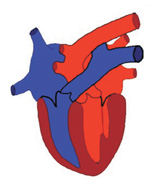The Heart
 It is a muscular pump with four chambers and a system of one way valves. It is the centre of the circulatory system which delivers vital oxygen to and removes waste carbon dioxide from every single cell in the body. Blood circulates in a closed system of blood vessels. Arteries deliver blood from the heart to networks of tiny blood vessels called capillaries. Veins collect blood from the capillary networks and return it to the heart. The atria are receiving chambers and act as fillers for the powerful ventricles which beat (contract) and push blood out to the lungs and the body.
It is a muscular pump with four chambers and a system of one way valves. It is the centre of the circulatory system which delivers vital oxygen to and removes waste carbon dioxide from every single cell in the body. Blood circulates in a closed system of blood vessels. Arteries deliver blood from the heart to networks of tiny blood vessels called capillaries. Veins collect blood from the capillary networks and return it to the heart. The atria are receiving chambers and act as fillers for the powerful ventricles which beat (contract) and push blood out to the lungs and the body.
The heart beats in an automatic sequence controlled by the brain. Blood returns to the right heart in the great veins (blue on diagram). It enters the right atrium (RA) and passes into the right ventricle (RV) which contracts and pushes blood into the lungs where it picks up oxygen and gets rid of carbon dioxide. Blood returns from the lungs to the left heart (orange on diagram). It enters the left atrium (LA) and passes into the left ventricle (LV) which contracts and pushes blood into the great artery called the aorta. The elastic walled aorta receives blood and recoils to push blood around the body.
This sequence of events: body > great veins > RA > RV > lungs > LA > LV > aorta > body is called the cardiac cycle.
The left side of the heart is a high pressure system compared with the right because it requires more force to push blood around the body.
The heart is surprisingly small and weighs less than 100th of the whole body weight. Hearts of athletic animals like thoroughbred horses and greyhounds are twice the size of other mammals. Heart size can be increased by fitness training.
The passage of blood through the normal heart is always in a forward direction. When the heart beats backflow is prevented by one way valves situated between the chambers on the right and left and at the base of the great vessels.
Closure of valves causes vibrations which give rise to the familiar lubb dupp first and second heart sounds. Lubb is produced when valves close the gap between atria and ventricles. Dupp is produced when valves close the openings at the base of the great vessels.
The heart rate is the number of times the heart beats in a minute.
Resting (relaxed) heart rates are in the region of:
- Horse: 24 – 40
- Elephant: 25
- Cow: 65
- Sheep: 75
- Human: 50 – 100
- Cat: 120 – 240
- Large dog: 70 -140
- Toy dog: up to 180
- Puppies: up to 220
- Rabbit: 180 – 300
- Mouse: 300 – 800
- Shrew: 600

